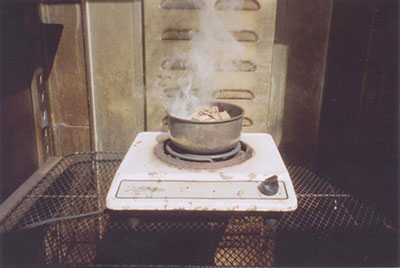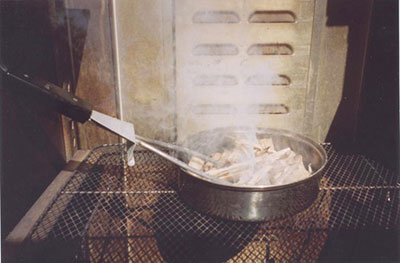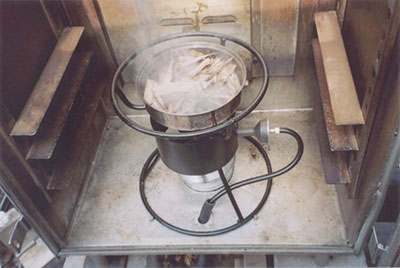Meats and Sausages
Smoke Generation
Smoke can be generated by:
- Burning wood. Due to the danger of flames, this method is limited to smokers with a separate fire pit.
- Heating wood chips or sawdust with an electrical wire (barbecue starter). Once started, they keep on smoldering and the wire starter is not needed anymore.
- Heating wood chips or sawdust over a gas flame.
- Placing wood chips over hot coals.
The preferred method to handle wood chips or sawdust is to place them in a stainless steel pan, about 8 -10” in diameter, and leave it on a hot plate, hot coals, gas burner, or barbecue starter until sawdust starts to smoke. An additional amount of sawdust or wood chips should be added once in a while to maintain smoke generation.
If smoking stops, the barbecue starter or hot plate is reconnected again. If the sawdust bursts into flames, any common spray bottle can bring it under control. The wood chips should be kept together in a conical pile so that they will smolder and not burn. The moment they spread, they make contact with more air and are more inclined to burn. The same applies when adding wood chips directly on hot coals or ashes, keep them in a pile and if the flames start to grow bigger, add more wood chips to cut off the supply of fresh air. After a while, a natural rhythm of adding sawdust will be established and the whole process will go on smoothly.
All small and medium-sized factory-made smokers use these methods to generate smoke. The bigger models employ a free-standing smoke generation unit that is connected to the smoker by a short pipe. Draft control plays no role here since an electrical blower blows the smoke into the smoker. Industrial smokehouses choose still different methods of smoke generation but that does not necessarily mean that the quality is better. One method involves pressing blocks of pressed sawdust against rotating wheels. That resistance creates high temperatures and the block of wood starts to smoke. It’s like cutting a piece of wood with a dull saw blade; it starts to smoke because of the heat generated.
To learn more about smoke generation visit Smoke Generators



















